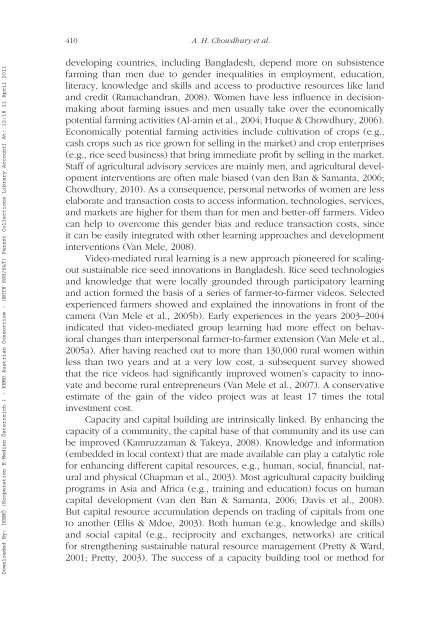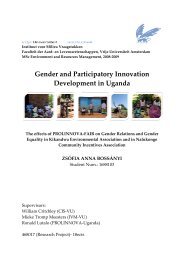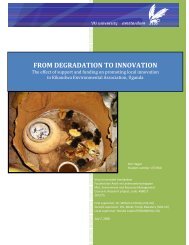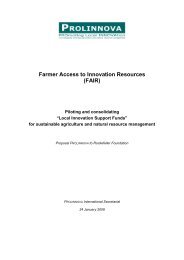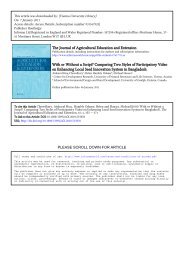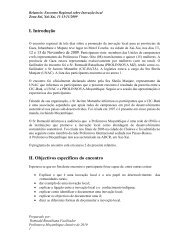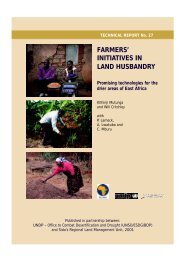Chowdhury et al (2011); PDF file - Prolinnova
Chowdhury et al (2011); PDF file - Prolinnova
Chowdhury et al (2011); PDF file - Prolinnova
Create successful ePaper yourself
Turn your PDF publications into a flip-book with our unique Google optimized e-Paper software.
410 A. H. <strong>Chowdhury</strong> <strong>et</strong> <strong>al</strong>.<br />
Downloaded By: [KEMÖ (Kooperation E-Medien Österreich ) - KEMO Austrian Consortium - (BOTH SSH/S&T) Parent Collections Library Account] At: 12:18 11 April <strong>2011</strong><br />
developing countries, including Bangladesh, depend more on subsistence<br />
farming than men due to gender inequ<strong>al</strong>ities in employment, education,<br />
literacy, knowledge and skills and access to productive resources like land<br />
and credit (Ramachandran, 2008). Women have less influence in decisionmaking<br />
about farming issues and men usu<strong>al</strong>ly take over the economic<strong>al</strong>ly<br />
potenti<strong>al</strong> farming activities (Al-amin <strong>et</strong> <strong>al</strong>., 2004; Huque & <strong>Chowdhury</strong>, 2006).<br />
Economic<strong>al</strong>ly potenti<strong>al</strong> farming activities include cultivation of crops (e.g.,<br />
cash crops such as rice grown for selling in the mark<strong>et</strong>) and crop enterprises<br />
(e.g., rice seed business) that bring immediate profit by selling in the mark<strong>et</strong>.<br />
Staff of agricultur<strong>al</strong> advisory services are mainly men, and agricultur<strong>al</strong> development<br />
interventions are often m<strong>al</strong>e biased (van den Ban & Samanta, 2006;<br />
<strong>Chowdhury</strong>, 2010). As a consequence, person<strong>al</strong> n<strong>et</strong>works of women are less<br />
elaborate and transaction costs to access information, technologies, services,<br />
and mark<strong>et</strong>s are higher for them than for men and b<strong>et</strong>ter-off farmers. Video<br />
can help to overcome this gender bias and reduce transaction costs, since<br />
it can be easily integrated with other learning approaches and development<br />
interventions (Van Mele, 2008).<br />
Video-mediated rur<strong>al</strong> learning is a new approach pioneered for sc<strong>al</strong>ingout<br />
sustainable rice seed innovations in Bangladesh. Rice seed technologies<br />
and knowledge that were loc<strong>al</strong>ly grounded through participatory learning<br />
and action formed the basis of a series of farmer-to-farmer videos. Selected<br />
experienced farmers showed and explained the innovations in front of the<br />
camera (Van Mele <strong>et</strong> <strong>al</strong>., 2005b). Early experiences in the years 2003–2004<br />
indicated that video-mediated group learning had more effect on behavior<strong>al</strong><br />
changes than interperson<strong>al</strong> farmer-to-farmer extension (Van Mele <strong>et</strong> <strong>al</strong>.,<br />
2005a). After having reached out to more than 130,000 rur<strong>al</strong> women within<br />
less than two years and at a very low cost, a subsequent survey showed<br />
that the rice videos had significantly improved women’s capacity to innovate<br />
and become rur<strong>al</strong> entrepreneurs (Van Mele <strong>et</strong> <strong>al</strong>., 2007). A conservative<br />
estimate of the gain of the video project was at least 17 times the tot<strong>al</strong><br />
investment cost.<br />
Capacity and capit<strong>al</strong> building are intrinsic<strong>al</strong>ly linked. By enhancing the<br />
capacity of a community, the capit<strong>al</strong> base of that community and its use can<br />
be improved (Kamruzzaman & Takeya, 2008). Knowledge and information<br />
(embedded in loc<strong>al</strong> context) that are made available can play a cat<strong>al</strong>ytic role<br />
for enhancing different capit<strong>al</strong> resources, e.g., human, soci<strong>al</strong>, financi<strong>al</strong>, natur<strong>al</strong><br />
and physic<strong>al</strong> (Chapman <strong>et</strong> <strong>al</strong>., 2003). Most agricultur<strong>al</strong> capacity building<br />
programs in Asia and Africa (e.g., training and education) focus on human<br />
capit<strong>al</strong> development (van den Ban & Samanta, 2006; Davis <strong>et</strong> <strong>al</strong>., 2008).<br />
But capit<strong>al</strong> resource accumulation depends on trading of capit<strong>al</strong>s from one<br />
to another (Ellis & Mdoe, 2003). Both human (e.g., knowledge and skills)<br />
and soci<strong>al</strong> capit<strong>al</strong> (e.g., reciprocity and exchanges, n<strong>et</strong>works) are critic<strong>al</strong><br />
for strengthening sustainable natur<strong>al</strong> resource management (Pr<strong>et</strong>ty & Ward,<br />
2001; Pr<strong>et</strong>ty, 2003). The success of a capacity building tool or m<strong>et</strong>hod for


